-
Posts
4,017 -
Joined
-
Last visited
Content Type
Profiles
Forums
Gallery
Events
Posts posted by glbarlow
-
-
You have so many creative clamps and clamping methods, they’re a story in and of themselves. Nice, meticulous work as always.
- kirill4, Rik Thistle and Blue Ensign
-
 3
3
-
- JpR62, Edwardkenway, Rik Thistle and 8 others
-
 11
11
-
21 minutes ago, BobG said:
Proxxon lathe to be easier and more precise to use than the power drill method? What's the longest dowel that the Proxxon will take?
Thanks Bob. Definitely easier, I’m not sure about more precise, that’s more about the person holding the sandpaper. The mast is about 250mm and it was no problem. I think that’s about getting a good secure and level set in the 3-jaw chuck (a necessary accessory). I repositioned it a few times to get the stock spinning more or less level. I don’t think I’ll need to turn anything much longer than Cheerful’s mast.
-
56 minutes ago, Chuck said:
in the homestretch..
Thanks Chuck, much appreciated. I realized I’m down to the rigging and done making things for the most part. I’m almost a little disappointed by that, it’s been such fun this past 10 months. Doesn’t mean I want to drop it and start over again though, that still hurts.35 minutes ago, DelF said:making those concentric circles.
Thanks Derek. A Proxxon router bit helped with that, I just sort of wing it and see what happens.
I think I provided the details for that planer in an early post. You should pick one up, it could do great things in your skilled hands.
-
Bowsprit and Mast
With all the hull and deck furnishings made its time to mount them to the deck…except it isn’t. I decided I needed to make the bowsprit to ensure I put the bowsprit step in the right place and I shaped the main mast to ensure the mast coat and mast slot were correct and because I was on a roll turning square things round.
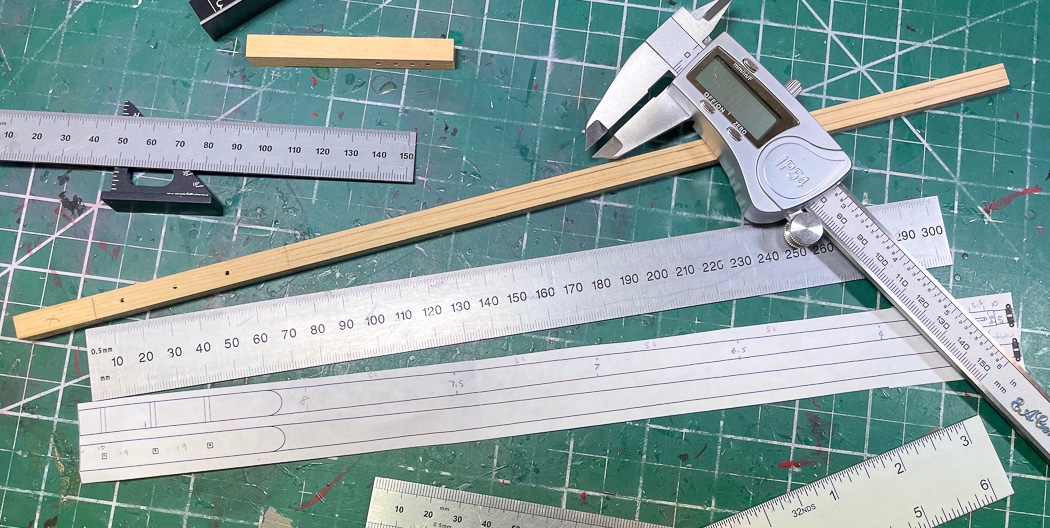
Thanks to my having to restart after my dropped hull (still makes me shudder almost a year later) I have two sets of plans. This has come in handy, allowing me to do cut outs of various sections while keeping one set whole. In this case I cut the bowsprit and mast so I have them right by the work piece. I marked the square piece of cedar using the 7-10-7 rule and used the mill as a drill press to drill the three holes at the base - I later used a file to square the two forward holes that would be visible once mounted. I also drilled the hole for the sheave at the forward end, much easier to to that while its squared - and as advised by Chuck’s monograph.
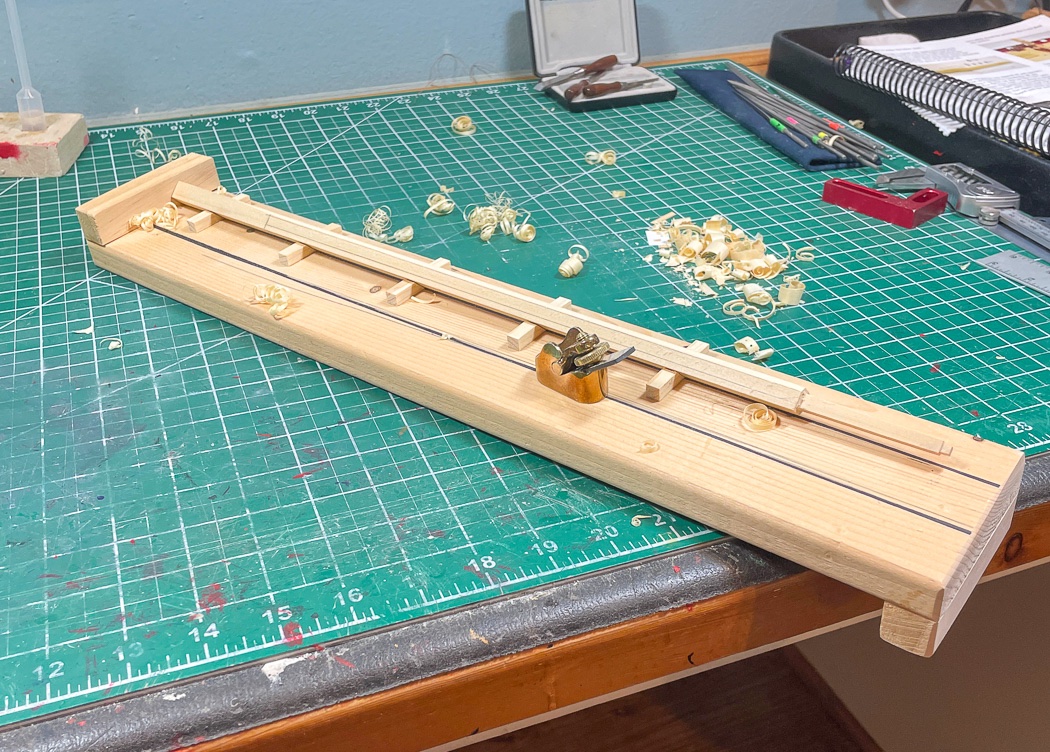
Then to the jig I sorted of copied from Derek to convert the square into an octagon for both the mast (shown here) and the bowsprit using my quite handy finger plane, that once again proved perfect for the job. I’ve mentioned before I’ve never had any luck with planes, but this little jewel works perfectly in making long smooth strokes on the square edge. The key, for me anyway, is to expose very little of the cutting blade on the bottom so it only takes a little wood off per stroke. I’d rather do more strokes than go too deeply into the wood.
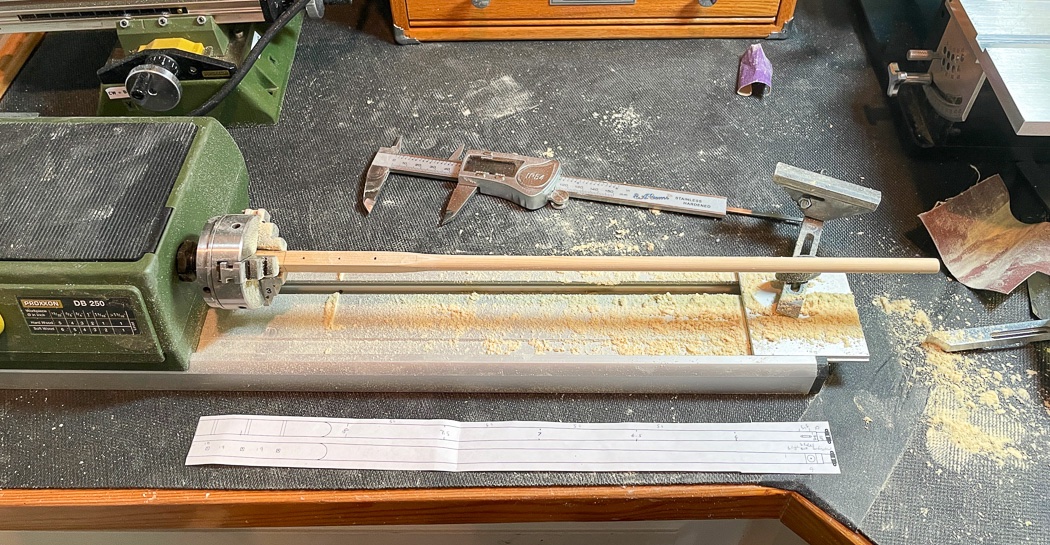
Then it’s off to the lathe for its first real use. I left enough stock on the end for the chuck to grab onto. I had been concerned (not sure why it was never an issue when I did it with a drill before getting the lathe) that there would be too much wobble not having both ends steady. It proved not to be a problem by using my right hand to steady the end while the left hand did the rounding. I used only various grits of sandpaper, 150, 220, 320 and 400 as I progressed, no tools needed. I took the measurements at incremental points along the stock (here the bowsprit, same thing for the mast) and stopped to check them frequently with digital calipers. I can’t put it back on, better to take it slow and enjoy the massive amount of sawdust it creates.
At least for this task there isn’t a huge difference in the lathe and the hand drill in doing the rounding. The big difference is the quick on/off to do checks and the placement and hold of the stock makes things easier than holding a drill. Some of the jigs I’ve seen for holding a drill are likely just as good, but the Proxxon DB250 is inexpensive and worth the price as I’m sure there is more I’ll do with it later. Another plus pointed out by Derek is the ability to push the wood thru the chuck which though not needed for masts and bowsprits will come in handy later for spars.
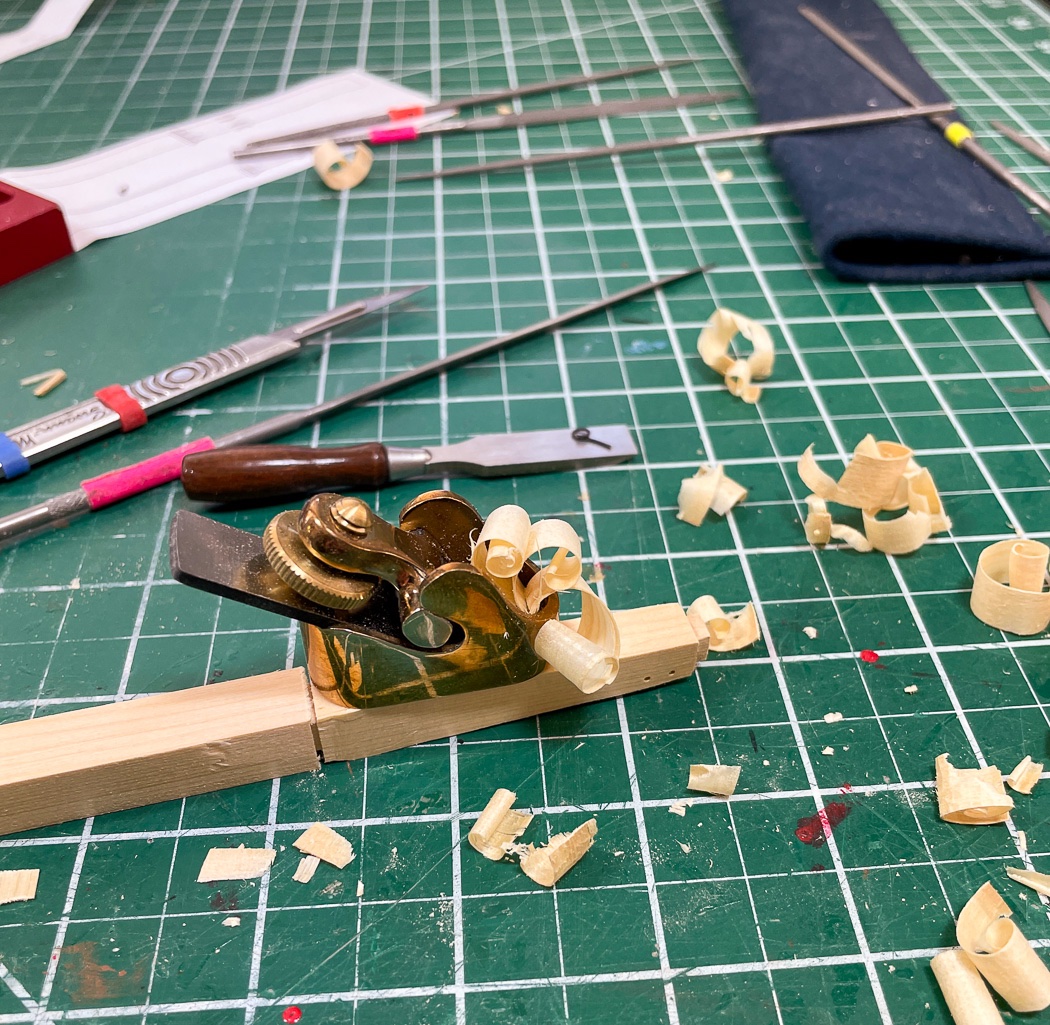
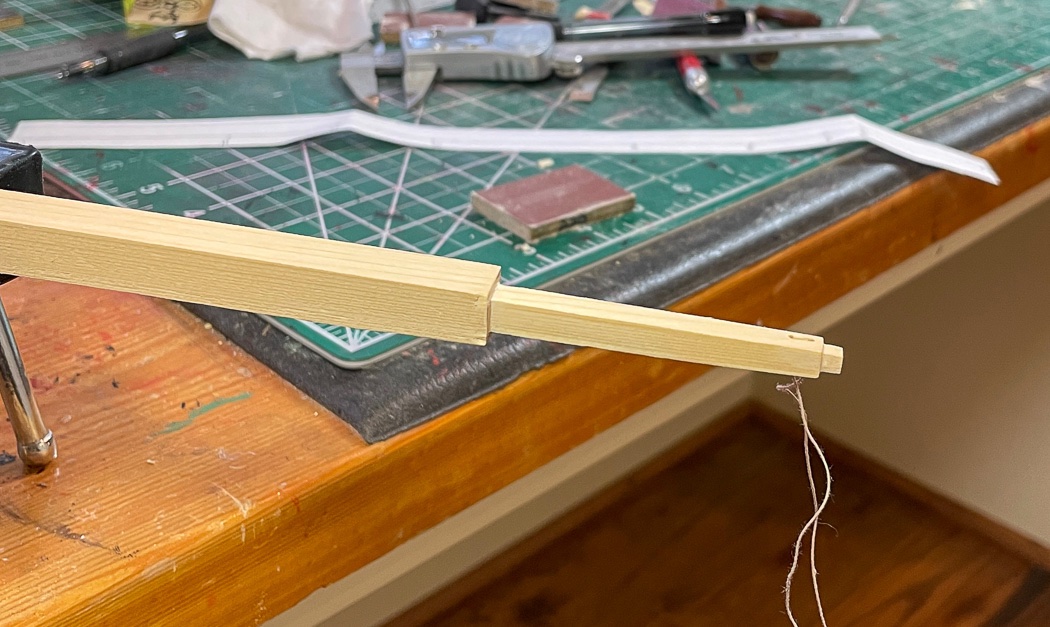
The mast is squared down at the top and includes an off center sheave - I did both before rounding the rest of the mast.
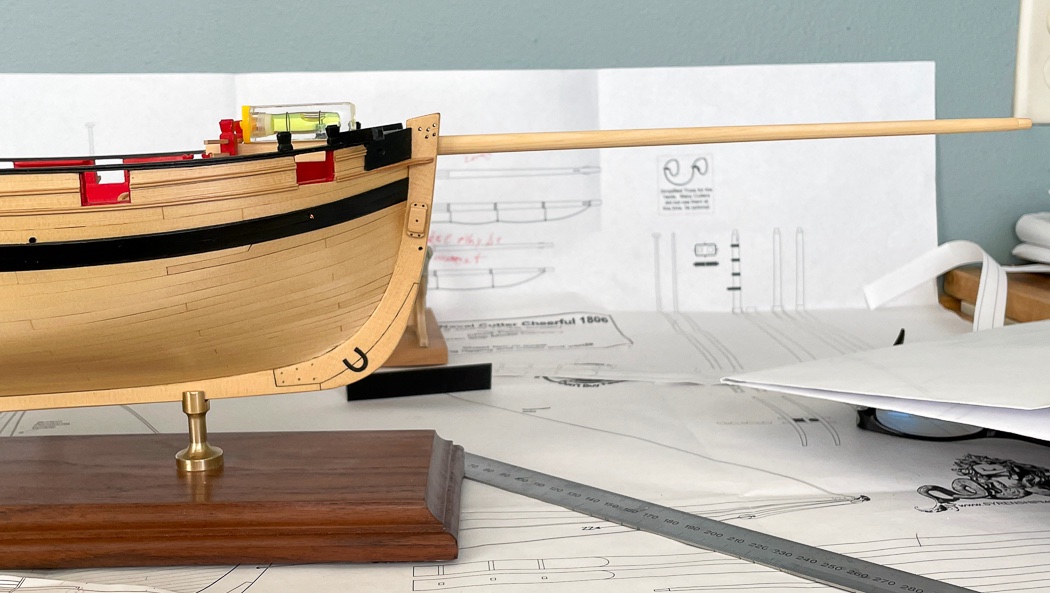
A quick check for fit. I sat the hull on its final stand temporarily to ensure when mounted there is a slight rise. It’s interesting how long the bowsprit is on a cutter relative to a square rigged ship.
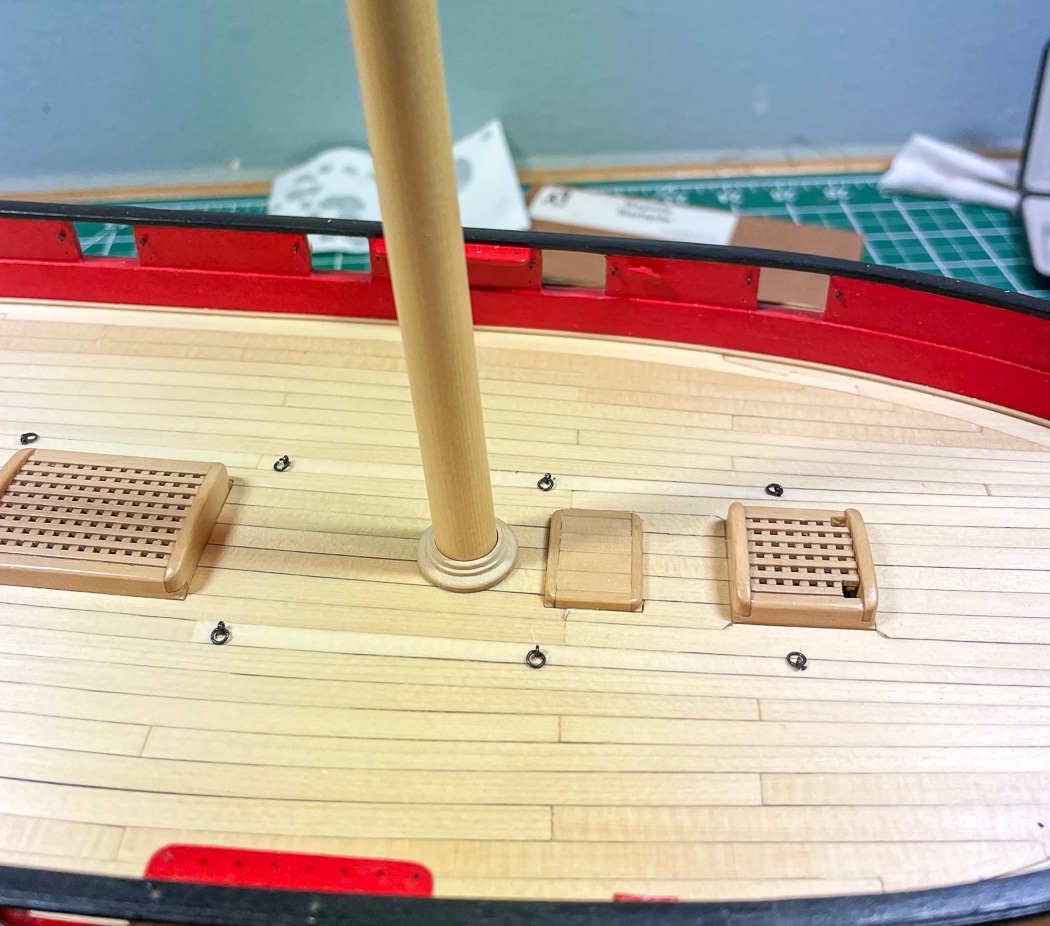
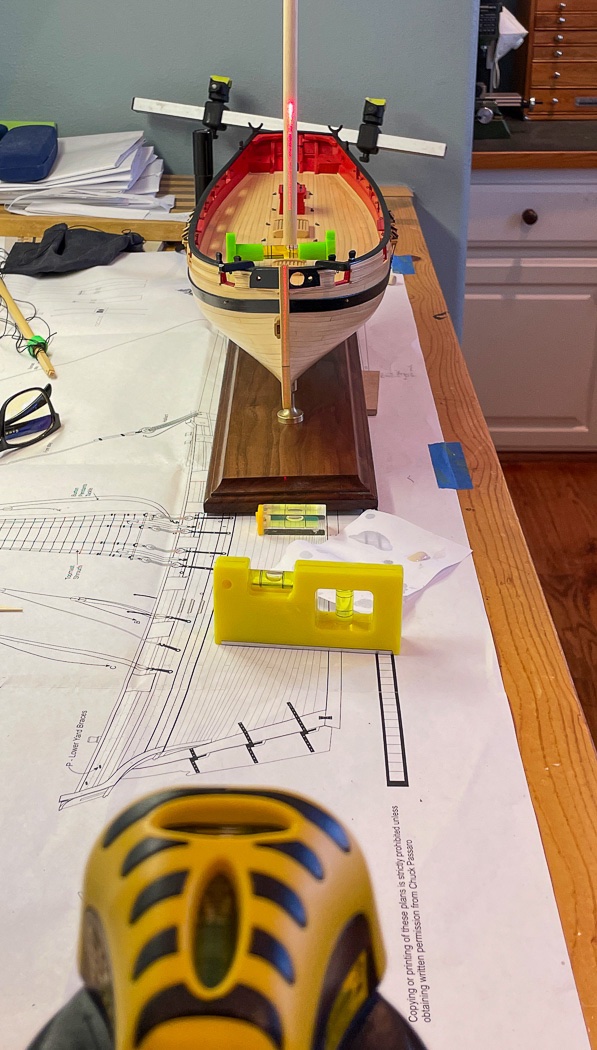
A check of the mast to make sure with the coat I can get it both level and slightly slanted towards the stern. It’s a little off in the photo, it won’t be when I mount it later. This step turned out to be worth the time, I did have to make minor adjustments. These were easy to do now, not so easy if I’d waited after all the deck furniture, the winch in particular, had been mounted. I got to make a new mast coat, the first was too small, but that’s ok, making them is kind of fun. This one from boxwood got a few coats of WOP after I was sure of the fit.
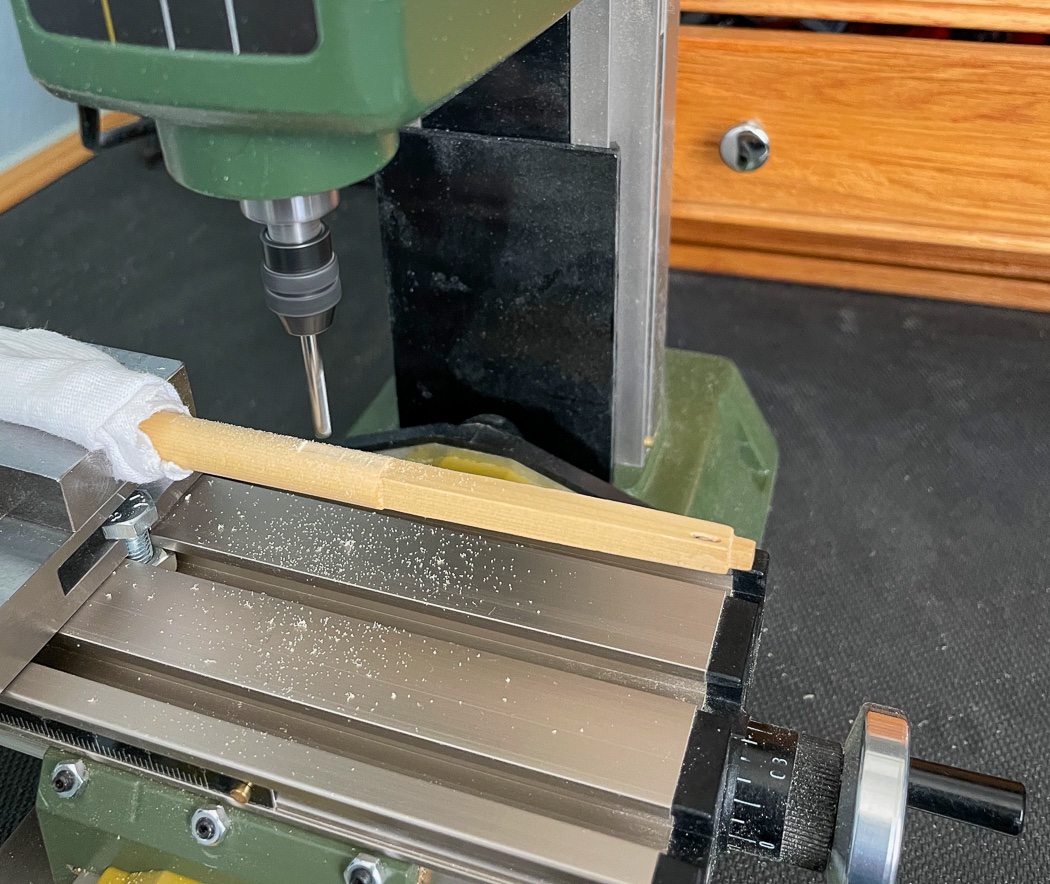
Another trip to the mill to flatten the area for the mast cheeks, just a .25mm deep cut for now, I will shape in more once I have the cheeks in hand.
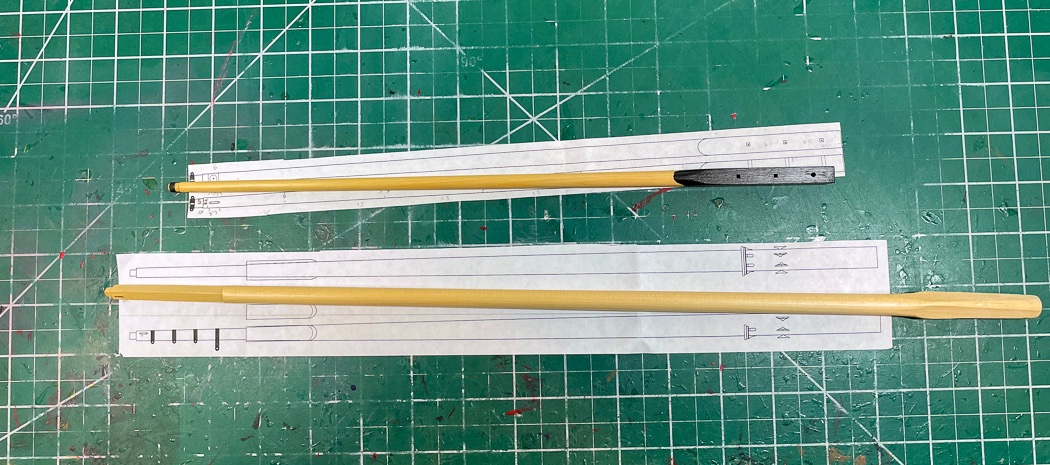
Following a couple of coats of WOP the bowsprit and mast are done for now. There is much more to do on the mast later (the photos are a bit out of sequence, I’d cut off the extra on the bottom of the mast before test fitting).
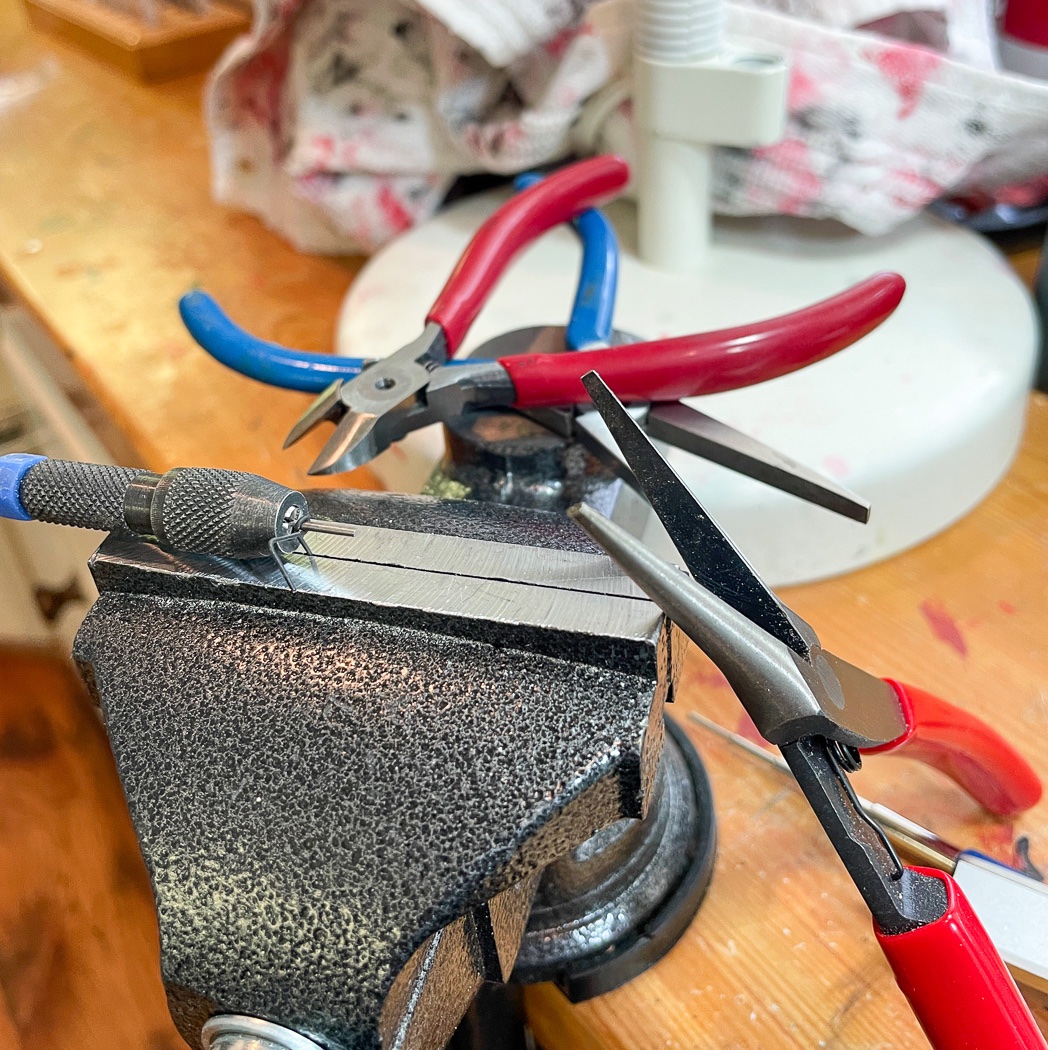
The bowsprit has an iron ring (black shrinkable wire wrap did the job) and four blocks. I added the ring and drilled the holes but will add the eyebolts and rings after the bowsprit is mounted. For me it’s easier to rig the blocks off the ship then glue them in (a practice I’ll follow throughout the rigging). The standard commercial eyebolts work in some circumstances on Cheerful, but not all - the bowsprit is one such place. The commercial versions were much too ’skinny’ to look right so I made four from 24 gauge black annealed wire.
I suppose everyone comes up with their own way of making these. I tried finding some options on MSW but didn’t really find anything I liked so I came up with my own using various pliers, shapers, cutters, and vise. I experimented and decided 1mm was the right size so I reversed a 1mm bit in a pin vise. A tight turn, a couple of bends and two cuts and I had it. It being (once again) my first time making these it took a little practice and rejects. But once I got on a roll, I made a bunch for all the eyebolts on the outer hull and cap rail as determined from the plans.
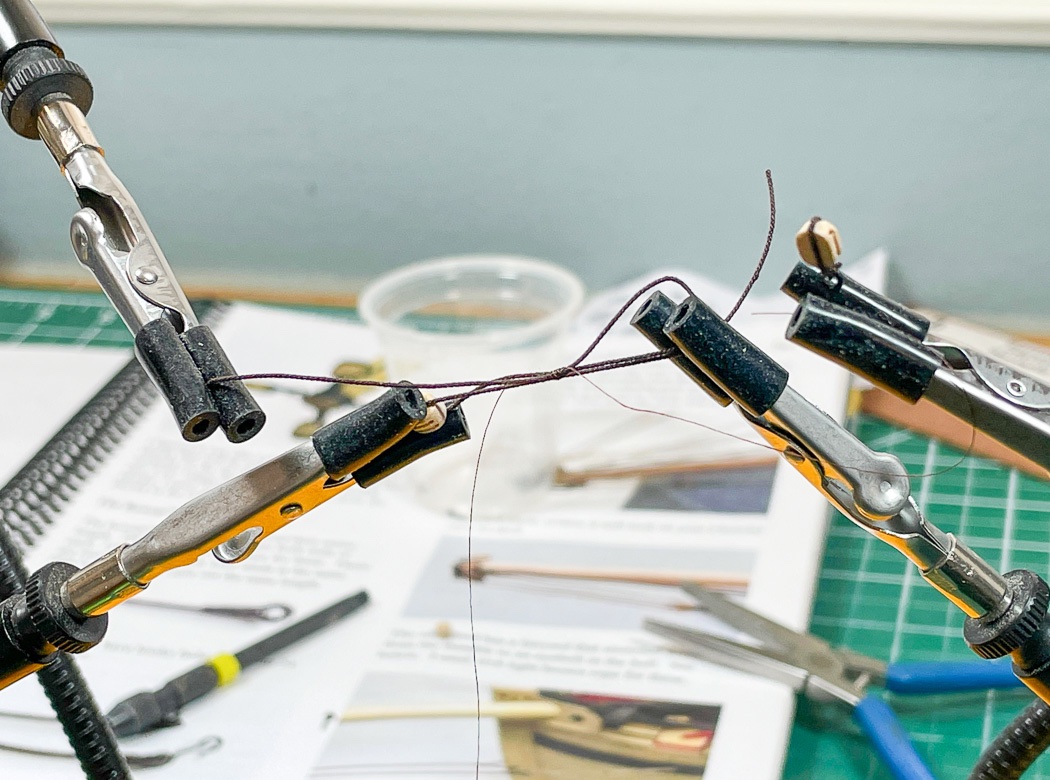
With eyebolts in hand I turned to the quad hands to rig the four blocks. I’m using fly fishing line to seize these and other blocks but will also use regular thread when I want the seizing to be more visible. Here I have the eyebolt (hidden from view on the right) in one loop and the block in the other. I use my standard loop and wrap method for all my seizings, it works for me. I’ve always had a third hand tool for this work, but the newly acquired quad hands is a big step up from those and well worth the expense. The flexible clip arms and having four to hold different things really makes the job easier. A completed block is shown on the far right, but the clip hides much of it.
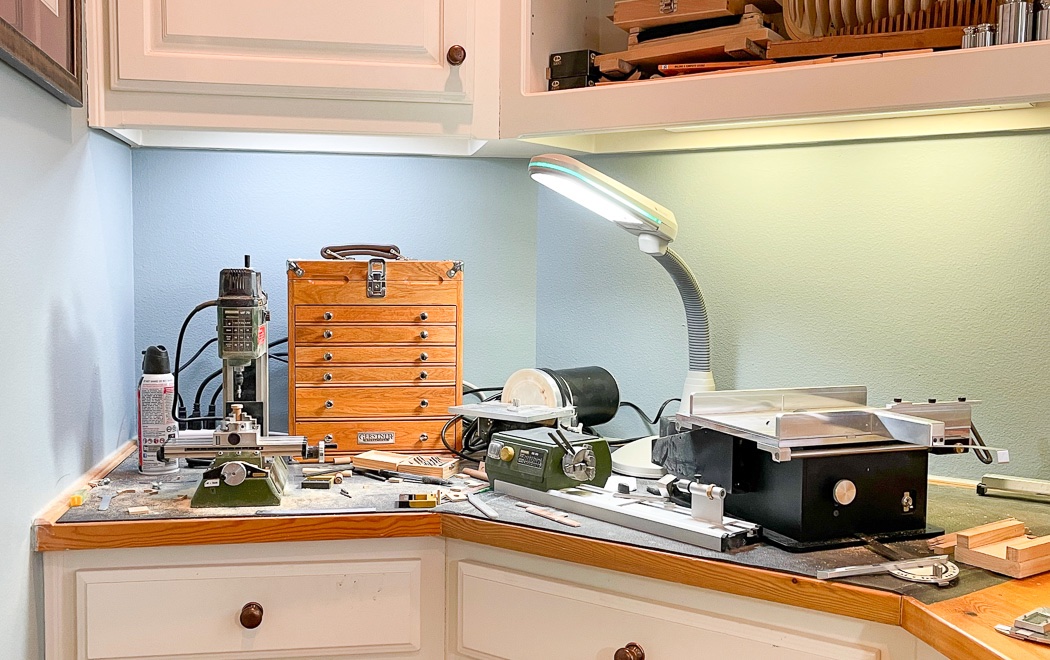
Thanks mostly to Cheerful, the power tool corner of my workshop has become a bit crowded. It’s usually not this much of a mess, I was working on the mill and the lathe at the same time. My shop dust filter was working overtime to clear the room as was my dust mask. The dust buster and broom came out after this photo. The tool chest holds all the accessories required for the power tools and was a Christmas gift from my supportive wife.
Much of this post probably seems mundane, but it accounts for a lot of time. These small ultimately taken for granted steps are integral to the completed model. For now the bowsprit, mast, and rigged blocks go onto the shelf (I have a literal shelf in one of my cabinets with a soft cloth lining) until its time to mount them. The next step, and the last prelude to mounting everything, is rigging the cannons. That will be my next post. It’s a long process to do one, then 11 more after that one.
Thanks for stopping by, the comments and likes are very appreciated.
- BobG, WalrusGuy, Nunnehi (Don) and 8 others
-
 11
11
-
Glad you like the mill, it really is a great tool.
-
Every moment spent fairing pays rewards later when planking, I suggest running lots of battens to check for a smooth run, 13 might be a bit high on the stern side.
-
How about for a pre-buy of Sphinx 🤣😂
- Chuck Seiler, Canute, KentM and 1 other
-
 4
4
-
Even wire gauge and dimensions of rings and eye bolts would help, hard to sort out from photos. I’m trying not to lean on Amati store bought for at least for some of the more visible.
- KentM and FrankWouts
-
 2
2
-
I'm sure it's simple, but would you mind showing your process/jig for making eye bolts? I keep winding up with the stem off-center. Also your thoughts on the size of split rings for 1:48 and the best gauge wire to use also for 1:48?
Again, it may be a sigh request but I'd to learn the best way to do these in bulk verses my struggling to churn out 4 for Cheerful's bowsprit.
- Gregory and FrankWouts
-
 2
2
-
-
-
-
The masts are the full length including what goes below the deck. The instructions don’t typically address tapering, that’s what the plans are for. As you gain experience you use the plans far more than the instructions. There will be a lot of belay points, ring bolts, blocks, and other misc stuff that’s only on the plans. Look through ALL the rigging plans before you mount masts or spars to find what’s needed. It’s far easier to add the detailed stuff off the boat than it is on. You’ll want to invest in ‘Quad Hands’ it will make rigging far easier, again doing as much off the ship as you can.
-
-
Yes, I put decking below the skylight, which can barely be seen but a glimpse is better than just painted black.
- FriedClams, Edwardkenway, Saburo and 2 others
-
 5
5
-
-
-
It’s all just so neat and sharp. Chris should replace his box art with yours.
-
Steady work,nice! I’m looking forward to seeing Cheerful decked out in pear wood.
- Saburo, JpR62, FriedClams and 1 other
-
 4
4
-
I have the 3 jaw Chuck, it works fine. I just made the fairly long bowsprit for Cheerful, really no different than had I used the drill I’ve always used before and it came out fine. It has an offset in the final 5mm which I cut ok but it was wobbly, a tail stock would come in handy. All sandpaper and files, no cutting tools.
How do you handle long spars pushing through the chuck without marring them when the chuck is tightened, I guess the old tape wrap trick. I can work with it ok, just looking for a steadier hold.Doesn’t seem to matter, I can’t find the extension bed anyway
-
Anyone know where I can get an extension bed for my Proxxon DB250 lathe...besides Australia...?
-
A bit difficult to follow, I’m almost tempted to get mine out to see how it aligns, but Cheerful awaits.
-
The last two items for me to make in completing the hull are the elm tree pumps and the fixed block, the first from Chuck’s mini-kit the second a scratch build.
Elm Tree Pumps
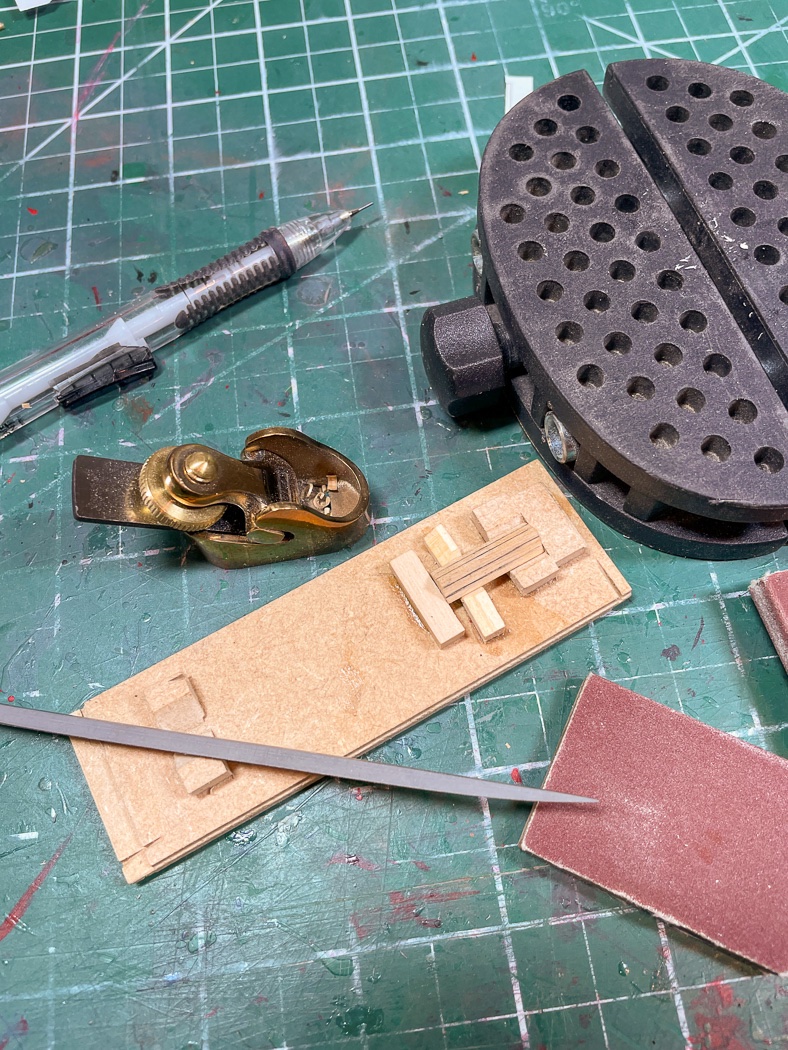
The first step is applying the 7-10-7 rule to a square piece of boxwood then using that to create the octagon shape of the pumps. The jig I used won’t win any ‘pretty’ awards, I modified it to work from a different jig, but is was effective in holding the small wood piece steady while I shaped it using my favorite finger planer. Between the planer, a file, and a sanding block I was fairly quickly able to get both pumps converted to octagons.
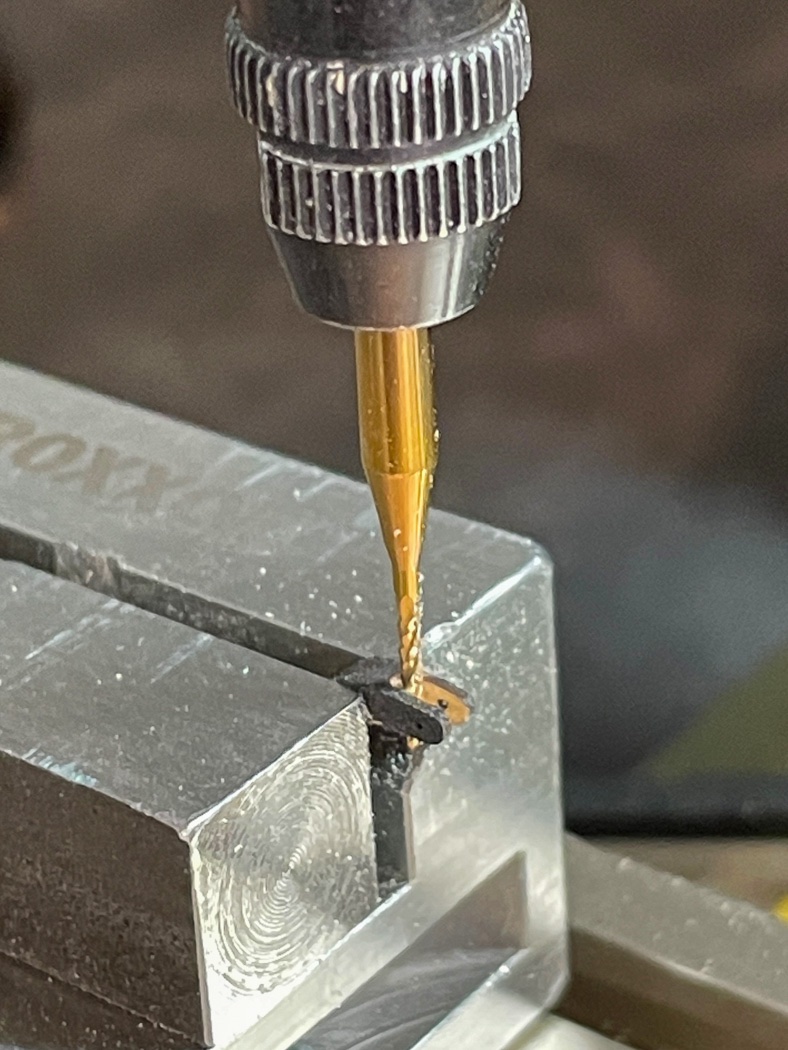
I painted the handle and bracket before removing these laser cut pieces from their frame knowing I’d have to paint them again, it made doing that easier. The bracket has to be slice cut at its top to accept the handle, so back to my favorite mill again. This could be done by hand with a file I’m sure, but again, there’s a mill just sitting there. Though a simple cut it is very delicate and requires careful measuring - as you can see there is not much room to be wrong. The resulting hinge opening is very delicate, I was fortunate not to break one but if I had Chuck does include 3 of both the handle and the bracket in the mini-kit.
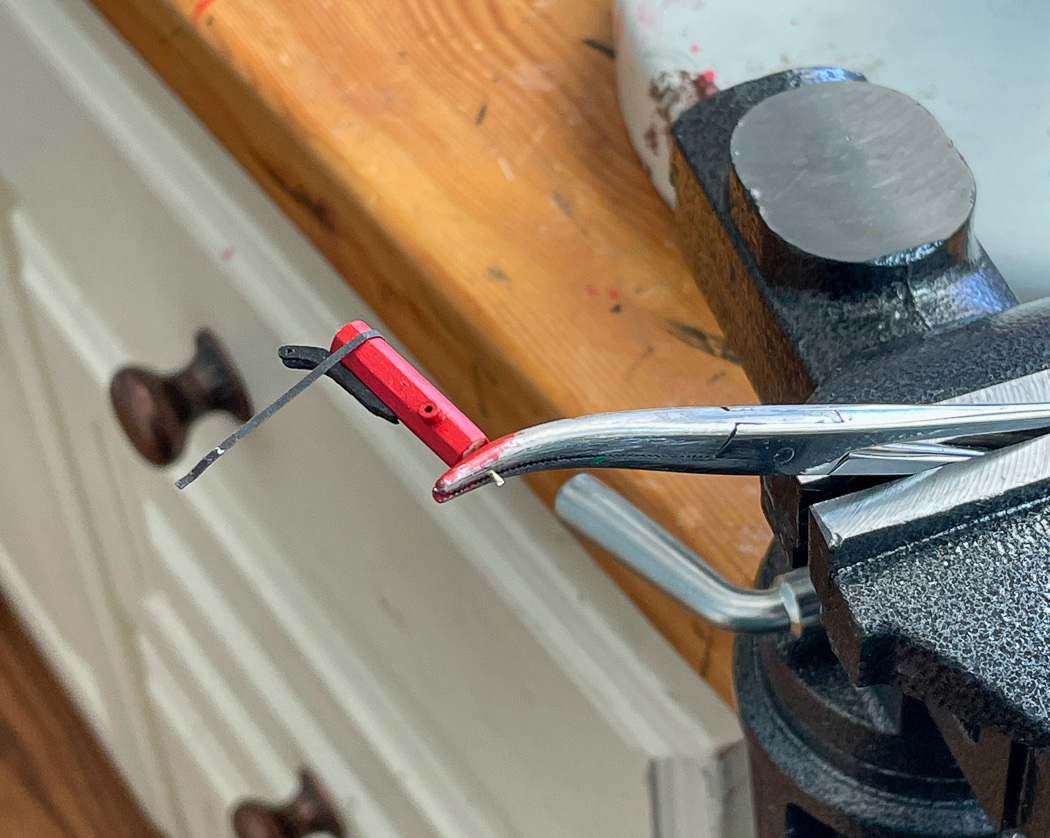
I drilled two holes at the proper deck location and inserted brass pins in the base of both pumps. It made it easier to add the spout and easier to paint holding them with my hemostats (more dental tools) as well as to install the metal (black paper) band around the top. Chuck provides enough strip if you want to add another band at the bottom. I like the way these look without that. Either way is historically accurate for those counting.
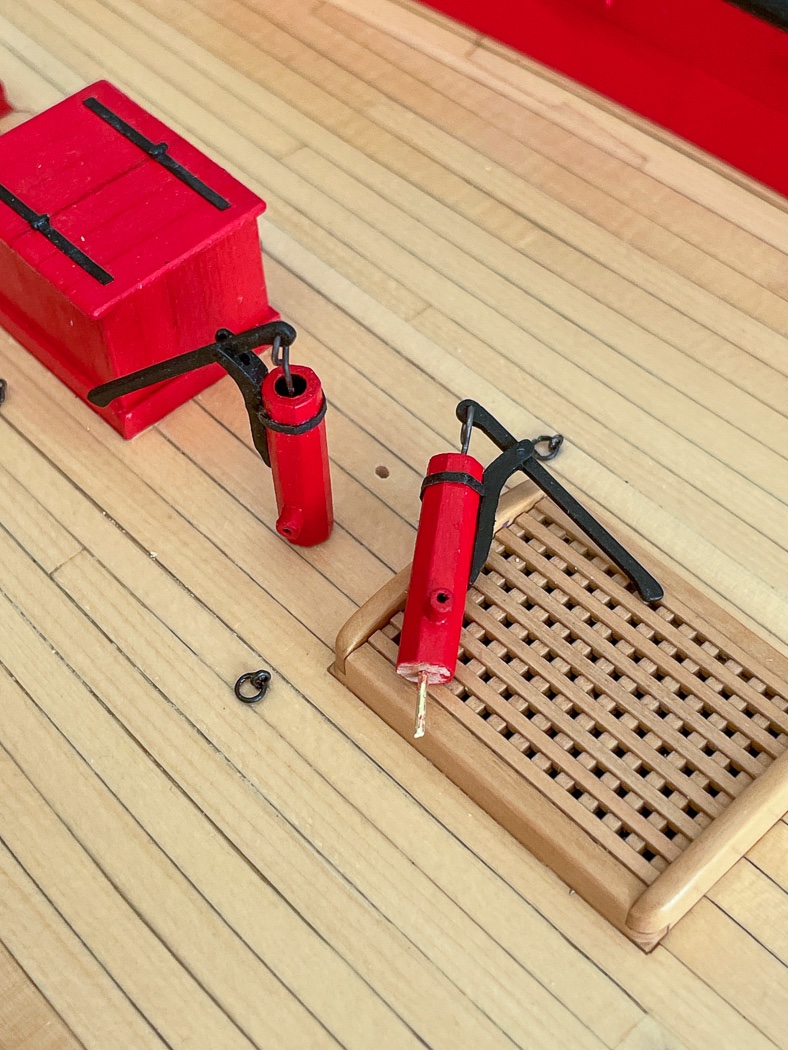
I rounded and softened the edges of the handle for a used look. Lining up the wire pin through the bracket and handle was fun... A quick dry fit and then off they go to my construction shelf to be mounted later. The handles move so I can position them. I’ll have to watch closely to make sure they aren’t snagged during the rigging. Though they do move I did not test to see if they remove water from the bilge.
Fixed Block
Next up is the fixed block on the starboard side of the stem. For this I had only the plans to go by and consulting of other logs for ideas, once again the strength of MSW. This turned out to be a pleasant afternoon’s project start to finish. It was fun to figure out and make.
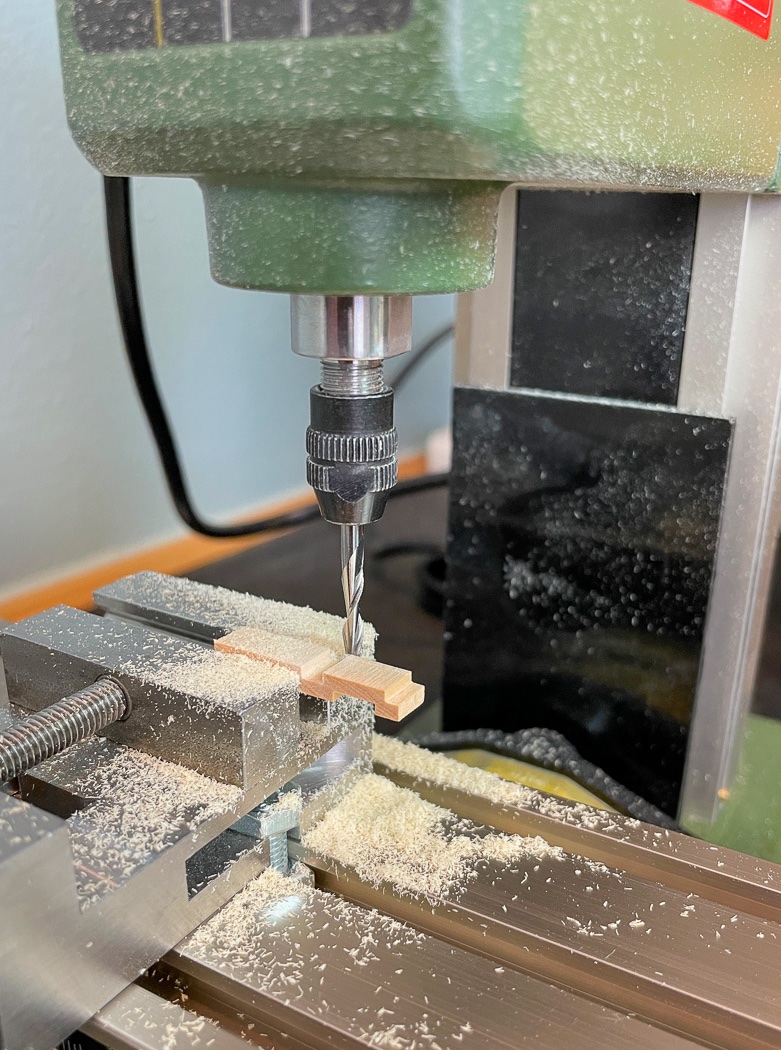
I started with a piece of scrap boxwood - I just love boxwood, it’s so nice to work with, shape and polish into shape. I’m glad when I have a use for it not calling for paint, it is also very complimentary to the model’s yellow cedar. I cut a piece longer than I needed 6mm wide (per the plans) and 3mm thick (just looked right, no way to tell from the 2 dimensional plans). I suppose I could have made it from a piece 2mm thick but with its required U shape I was concerned it might break at the joints. Of course this is a task the mill is perfectly designed for, much crisper and faster than I could have done it by hand. Have I mentioned how much I enjoy having the mill…
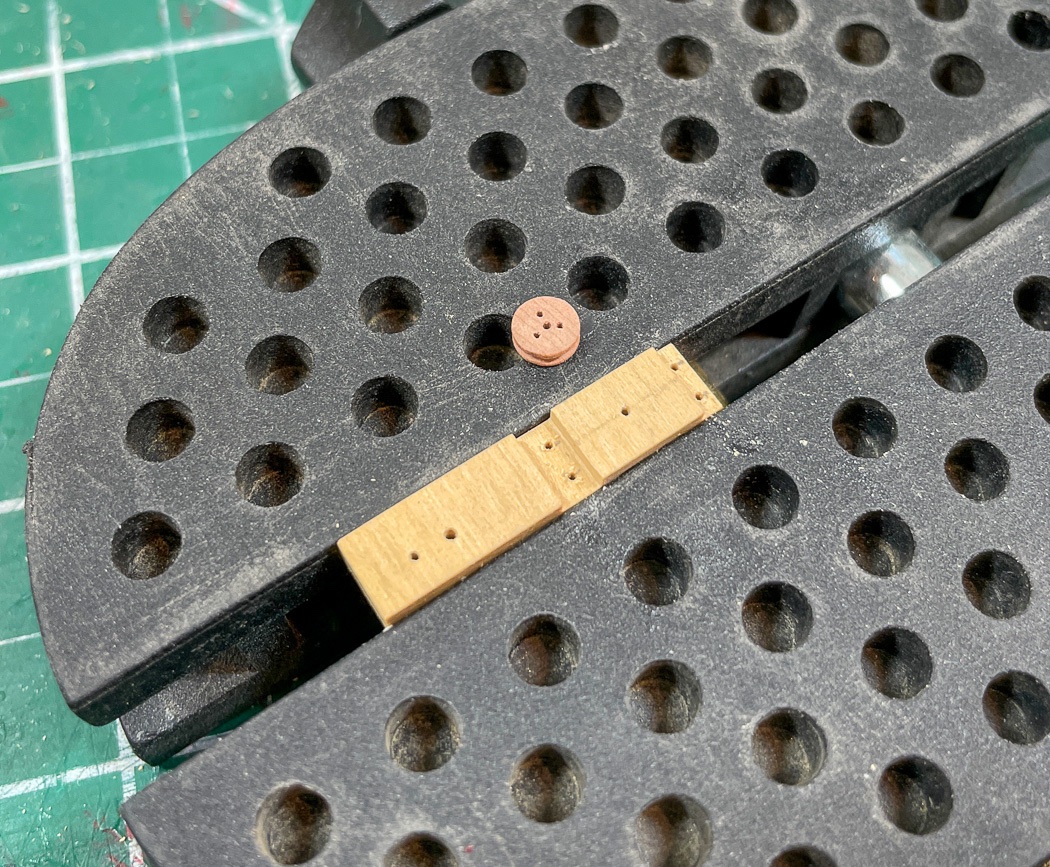
I failed to take a photo of the reverse side of the block - essentially it’s cut to a block form U (as can be seen in the previous photo). The plans call for the ‘indention’ to be 6mm long and deep enough to hold the sheave, and as it happens a perfect fit for a 5mm pear wood deadeye I took from my Speedy kit. I drilled a hole in the center of both the block and deadeye, I did have to sand the sides of the deadeye considerably for it to fit between the block and the stem, which is ok, it looks like a sheave now. I drilled a hole for a 22 gauge wire center for the sheave and four 24 gauge wire mounting holes.
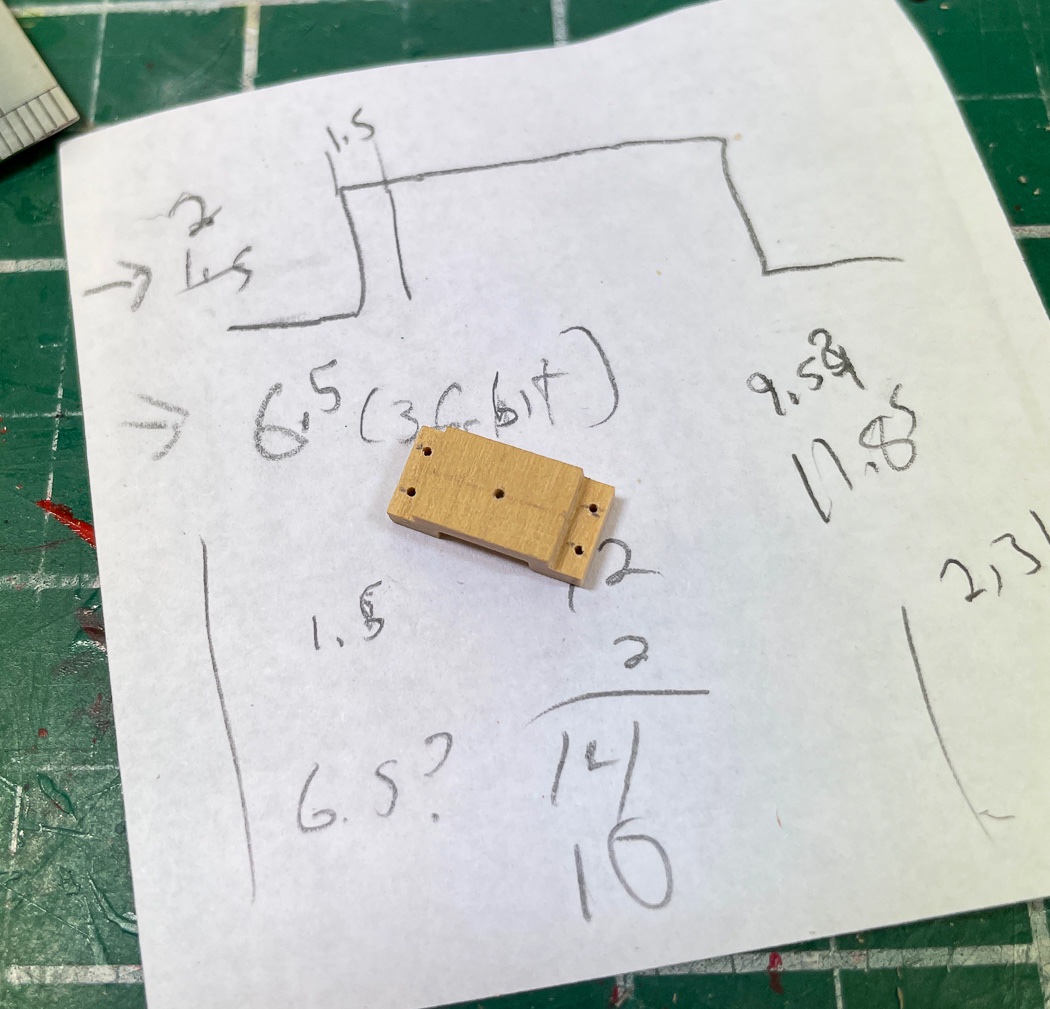
The extra length was handy for testing holes and for holding the piece both in the mill vise and on the work bench. Once everything was ready I carefully sliced it off with the cross cut sliding table on my Byrnes saw. You can also see the measurements (1mm turns of the axis wheels) and notations used for cutting it on the mill, I have to do this otherwise I lose track.
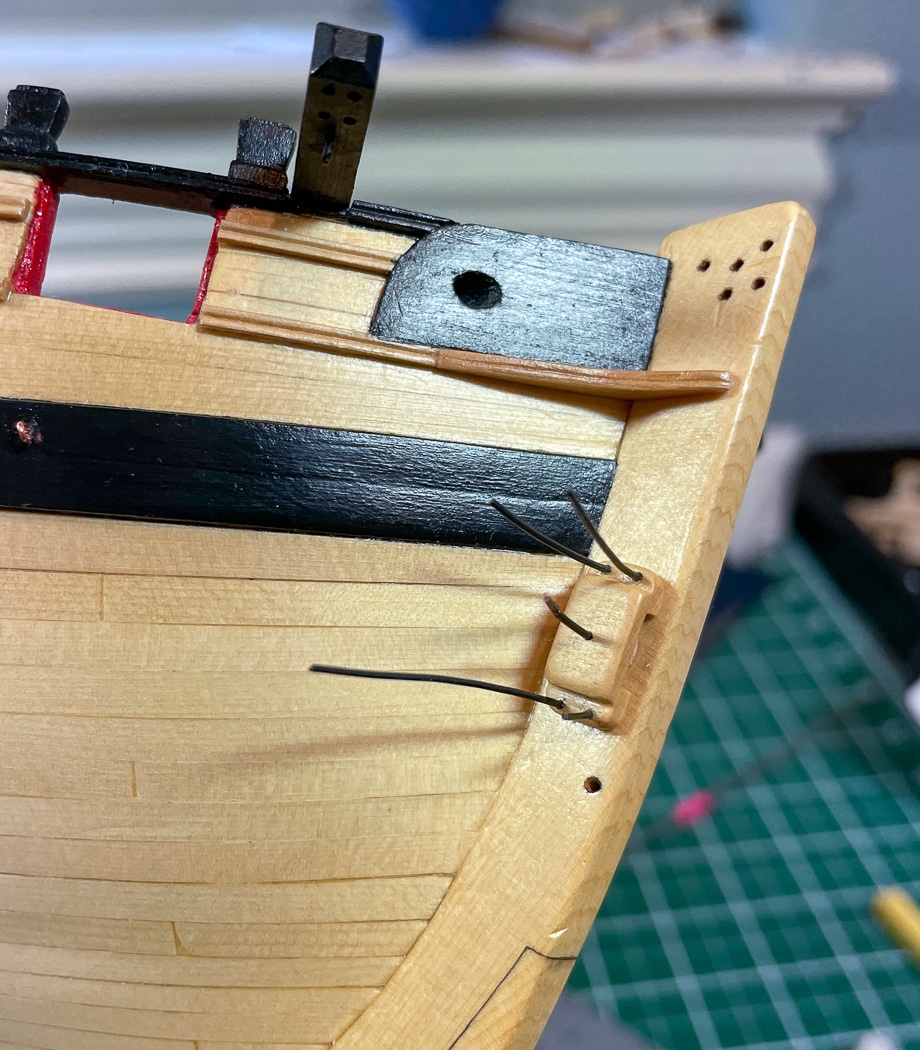
I spent a considerable amount of time with fine and extra fine sanding sticks to round it off and shaping it to look a little worn and pounded by the waves, then attached it with CA and firmed it up with the wire mounts. I had mounted the center wire and deadeye first. The uncut center wire was handy in giving me something to hold on to while lining it up on the stem. I roughed up the contact points where the block and stem meet for adhesion, there’s a lot of poly on the stem.
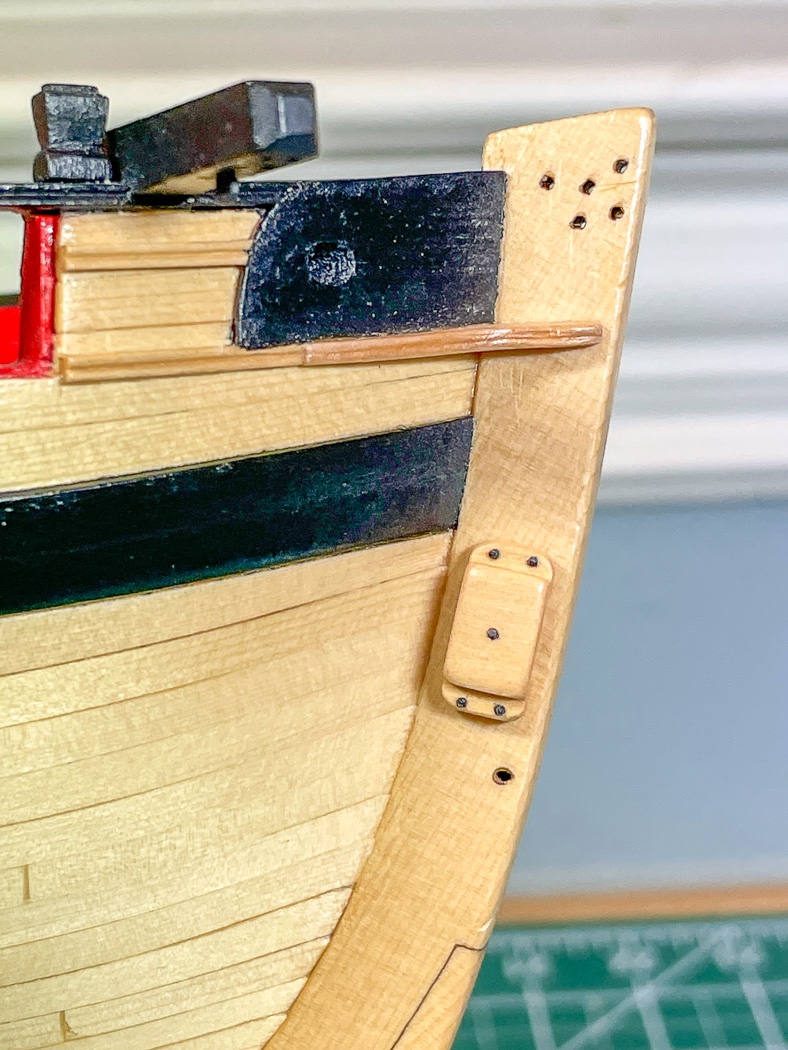
With the wires cut to stand proud and their tops painted Iron Work Black and a coat of WOP the block is done. So is all of the deck furniture, though most not yet mounted, making this something of a milestone. Next up is making the bowsprit. I need it to determine the location of other pieces. Once I have that done I’ll next rig the cannons while there’s room then mount the remaining deck furniture, bow sprit, and mast. I’ll pause to enjoy the work, then it’s time to rig.
One decision I haven’t made is whether to include anchor hawse running across the deck. I like the look but not sure I want to cut holes in the forward hatch, I’ll have to decide soon though.
Thanks for all the likes and comments, I appreciate and enjoy your taking the time.
- whitejamest, VTHokiEE, Ron Burns and 14 others
-
 17
17



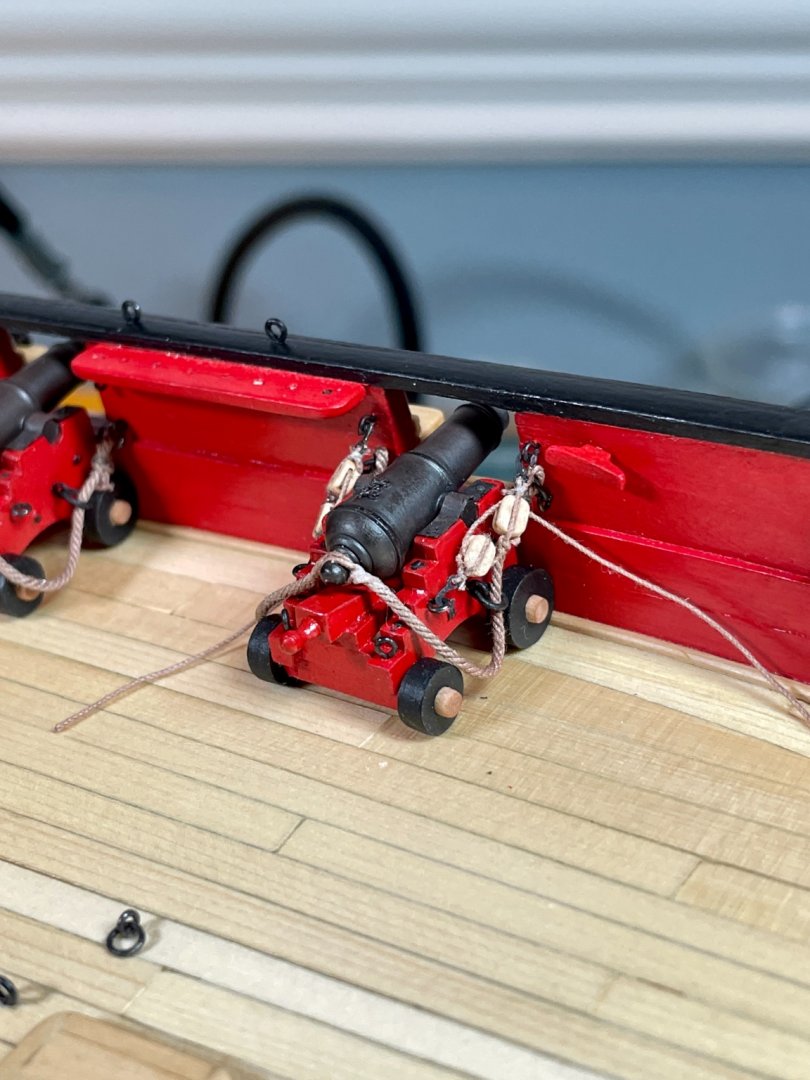

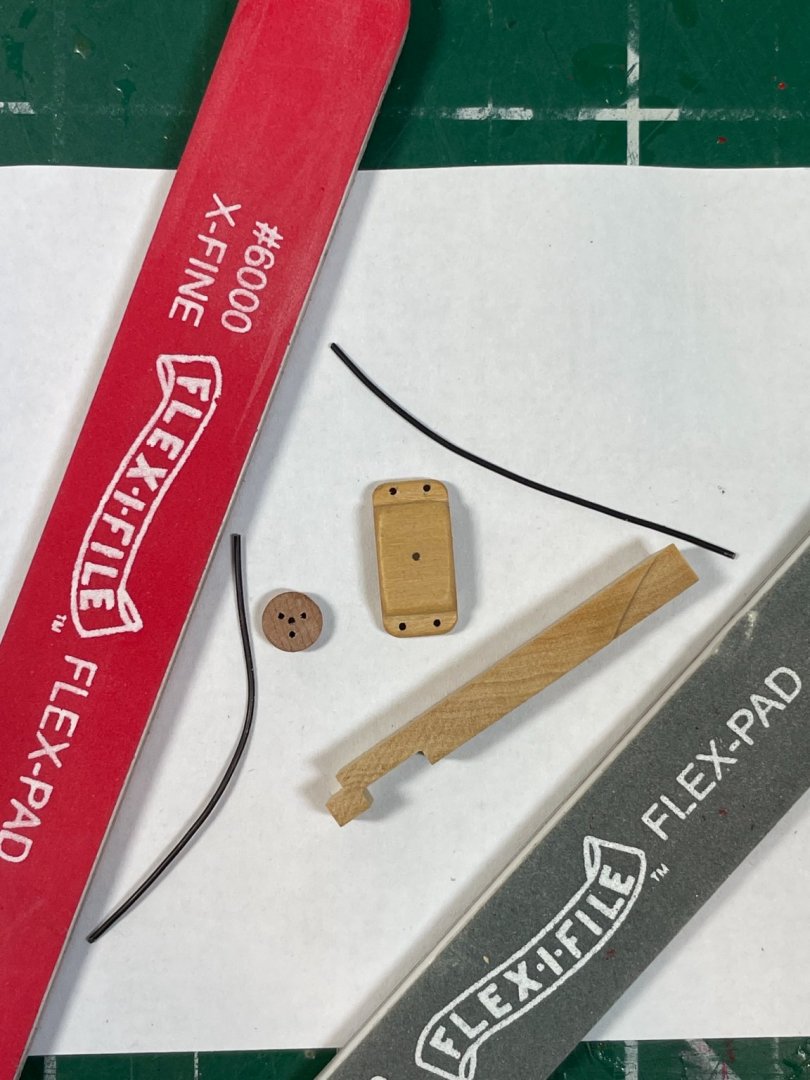
HMS Sphinx 1775 by James H - FINISHED - Vanguard Models - 1:64
in - Kit build logs for subjects built from 1751 - 1800
Posted
So you’ll be done by next Monday 😁 As always I’ll enjoy watching your build of one of Chris’s well researched designs.